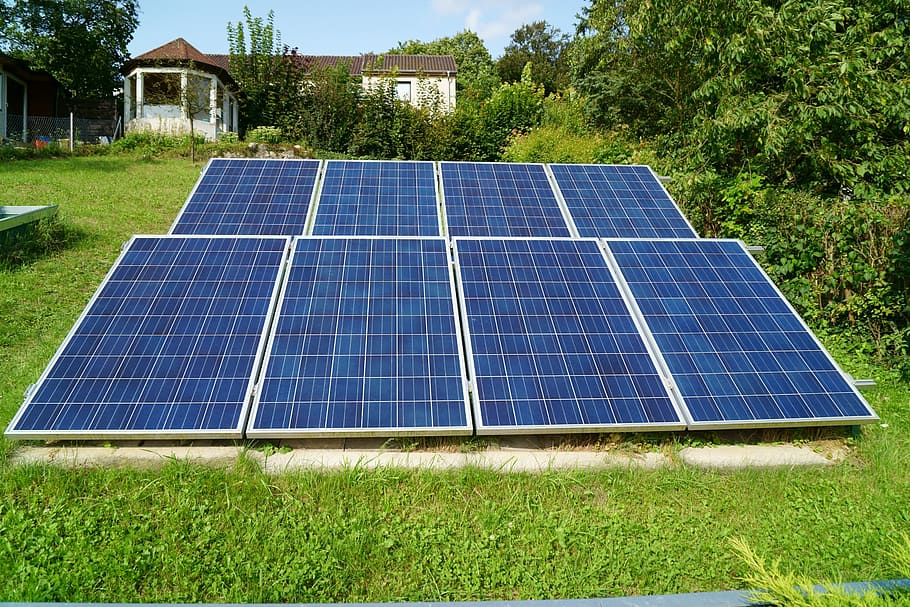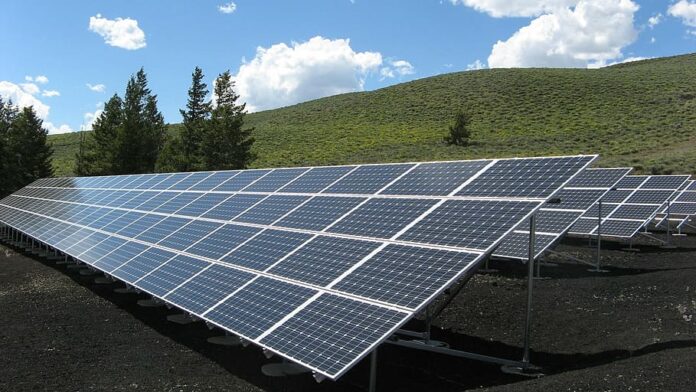Over these years, solar panel technology has been more developed and vast, and more incredible and inventive models of solar panels are now introduced to the market. You are planning to purchase a solar panel and don’t know what to do or which one to be purchased, but don’t worry about them. Nowadays, in the markets, there are three kinds of solar panel categories available which are thin film, monocrystalline, and polycrystalline solar panels. In this article, we’ll discuss monocrystalline vs. polycrystalline solar panels in detail. Hence, by comprising them with each other, we’ll find out which one is better and more suitable for your home.
Monocrystalline Solar Panel
Monocrystalline solar panels are basically composed of monocrystalline solar cells. As a semiconductor with high purity, monocrystalline solar panels get their name from the cylindrical silicon mass of metal from single-crystal silicon. It provides electrons more space to move freely for a preferable electric flow because it originated from a single crystal. They are of uniform color. The cylindrical ingot (mass of metal) is chopped into wafer-forming cells. They consist of circular wafers in an octagonal shape to provide a maximum number of utility to the cells. Because of their octagonal shape, they persist their look very unique.
Working of Monocrystalline Solar Panel
An electric field generates when sunlight falls on the panel by absorbing energy through the cells. After absorbing energy through cells, a highly complex process occurs to produce an electric field in the panel.
The produced electric field consists of Current (C) and Voltage (V). By working on this equation, VxI= P (Voltage x Current = Power) through Voltage and Current electric field generate power (p). This generated power is used to run different electric devices with direct current or indirect/Alternating current.
Characteristics of Monocrystalline Solar Panel
Monocrystalline solar panels exhibit photovoltaic properties among all the three types of solar panels; these are thin-film and polycrystalline solar panels. The features of Monocrystalline solar panels are as follows:
- These panels absorb more energy than the other panels due to the octagonal shape wafers and the pyramid pattern of the panel. This pyramid pattern of the panel provides a large surface area for collecting energy.
- The upper surface of the panel is diffused with phosphorus, which creates a direction that is negative in nature, and the lower side of the panel is electrically positive and hence creates a positive direction. With these positive and negative orientations, an electric field in the panel is generated.
- In monocrystalline solar panels, their cells are coated with silicon nitride to absorb more energy and reduce reflection in it.
- On the cells of the panel, metal conductors are printed; when electricity is produced in the panel, it is collected by them.
Cost of these Panels
As compared to polycrystalline or other types of solar panels, monocrystalline solar panels have a high cost/price because of the way they are manufactured. They also have high efficiency, and they also generate more power than the other panels; these are also the reasons for their high price. Monocrystalline solar panels are $0.005 per watt higher than polycrystalline solar panels; because of the improvement in manufacturing, the price difference between them is getting low. The average cost of the monocrystalline solar panel is from $1 to 1.50 per watt.
Advantages and Disadvantages of these Panels
Monocrystalline solar panels have many advantages, and as well as it has some disadvantages also. Some of the advantages of monocrystalline solar panels are described below you must read:
- The most beneficial advantage of these panels is that they have the highest efficiency out of all the types of other panels. Their efficiency is up to 17-22%, making them more efficient among all types of solar panels.
- These solar panels are more heat resistant.
- These types of mono solar panels generate high power, and their power capacity is higher than other panels.
- You don’t need a large space area where they’ll be installed; actually, they require less space due to their high efficiency.
- On cloudy days when sunlight is low as compared to the regular sunny days, they perform well.
- These panels are available with extended-lasting high warranties of at least 25-26 years. They are long-lasting as compared to the other types of solar panels, according to their manufacturers.
Like advantages, monocrystalline solar panels have some disadvantages as well, which are described below:
- Out of all the types of solar panels, monocrystalline is the most expensive one.
- During its manufacturing, while during the cutting of silicon, there is a lot of waste material in it.
- An increase in temperature affects its performance level; however, as compared to the other types of solar panels, its loss is less.

Polycrystalline Solar Panel
Polycrystalline solar panels are composed of several silicon crystals in a single photovoltaic cell. In polycrystalline solar panels to form their wafers, silicon crystals are melted together. During fabrication of the polycrystalline solar panels, the molten silicon is allowed to cool on the panel itself. The surface of these solar panels has a mosaic look. These panels are made up of many silicon crystals, and the panel is of shiny blue color and is of square shape. Because of several silicon crystals, the space between the cells is low, so movement is low. Solar energy is absorbed from the sun and converted this energy into electricity.
Working of Polycrystalline Solar Panel
Its working principle is based on PN Junction; when the sunlight falls on it breaks the energy into electrons as they flow in the form of electric current. The PN junction is between P-type and N-type materials. The P-type material has a deficient amount of electrons, and on the other hand, N-type materials have a sufficient amount of electrons in them. With photovoltaic cells, two electrodes are connected. On the surface of the lower electrode, a foil-like conductor is present, and on the surface of the upper electrode, there are some tiny wires present on it.
Read More: Air Conditioning Installations: How To Install Air Conditioner? All The Information You Need To know
Characteristics of Polycrystalline solar panels
Polycrystalline solar panels also have a variety of features that are described below:
- As compared to monocrystalline solar panels, polycrystalline solar panels are less heat resistant and have low efficiency.
- These panels can tolerate a maximum temperature of up to 87 degrees Celsius and a minimum temperature of -40 degrees Celsius.
- As compared to monocrystalline solar panels, polycrystalline solar panels have a coefficient of higher temperature.
- The density of polycrystalline solar panels is high.
Cost of these Panels
Usually, polycrystalline panels have less cost than monocrystalline solids. The average cost of these panels ranges from $0.90 to $1 per watt. Their price is less as compared to monocrystalline solar panels due to their manufacturing which is costly. They have low efficiency and generate powerless than monocrystalline solar panels.
Advantages and Disadvantages of these Panels
Like monocrystalline solar panels, polycrystalline solar panels also have advantages and as well as disadvantages. Many of its advantages are described below:
- These solar panels produce a small amount of waste due to their method of manufacturing, in which silicon wafers are applied to the panel in another way.
- Also, due to their eco-friendly nature to the environment. Each of their crystal does not require an individual shape and place because most of the silicon’s are utilized during their production.
- They consume very few and minimum amounts of fossil fuels for their manufacturing.
- Their use is possible with batteries and inverter technology as well.
- Although they are cheaper than monocrystalline solar panels and are affordable.
Some of the disadvantages of polycrystalline solid panels are described below:
- They can be easily damaged in high temperatures because they are less tolerant to high temperatures.
- Another disadvantage of this panel is that they are not long-lasting as compared to monocrystalline solar panels.
- Their deficiency is less, and they generate less power because the purity of the silicon in it is less as compared to the monocrystalline solar panels.
Monocrystalline Vs. Polycrystalline Solar panels Which One is Better?
We’ll compare some of the main factors of both monocrystalline and polycrystalline solar panels to select which one is better for your home. If you’ve read all the above-written info about both solar panels, then it’ll be very easy for you to decide which one you choose.
- Their efficiency: If we compare both the efficiencies of mono and polycrystalline solar panels, there is a massive difference between them; as I described above, the monocrystalline solar panels have higher efficiency than the polycrystalline solar panels.
- Their warranties: While purchasing solar panels, whether it is mono or poly or another type, you always want to know their warranties first. If we talk about their warranties, then monocrystalline solar panels offer a 25-year warranty while polycrystalline solar panel offers a warranty of 20 years. Hence monocrystalline solar panel offers a long-lasting warranty than polycrystalline solar panels.
- Their power factor: Monocrystalline solar panels generate more power and consume less space than polycrystalline solar panels because of their high efficiency. So, if the roof of yours have limited space, then a monocrystalline solar panel is much better for you because if you want more output, you can have it without giving further space.
- Their Temperature Coefficients: Monocrystalline solar panels, as compared to polycrystalline solar panels, have high efficiency because of their high-temperature coefficient, but their level of output degrades when the temperature rises. While polycrystalline solar panels are worth it when the temperature rises.
- Their Appearance: Monocrystalline solar panel appearance is uniform, while the appearance of a polycrystalline solar panel is shiny blue which is sometimes uneasy for eyes to see. Therefore, most of people refer to monocrystalline solar panels due to their uniform and smooth appearance.
- Their Cost: If we compare their costs, we’ll get to know that the monocrystalline solar panels have a high cost than the polycrystalline solar panels. The average cost of a monocrystalline solar panel ranges from $1 to $1.50 per watt due to its expensive manufacturing and is more advanced and worthy than polycrystalline. The average cost of a polycrystalline solar panel ranges from $0.90 to $1 per watt. The price difference is becoming low due to the manufacturing because it is getting advanced day by day.
What sort of sunlight powered charger endures the longest?
Both monocrystalline and polycrystalline silicon sun powered chargers keep going for quite a while, with life expectancies that go past their 25-year guarantees. And they are long lasting than others.
Conclusion
According to the above-detailed information about monocrystalline vs. polycrystalline solar panels, it is very easy for you to choose which one is better for your home and other places. In most of the factors, monocrystalline solar panels are considered much better than polycrystalline panels. I also suggest that monocrystalline solar panels are preferable and long-lasting as compared to polycrystalline solar panels. Now it is up to you which one you suggest to yourself better.

















